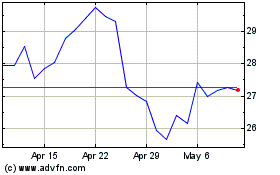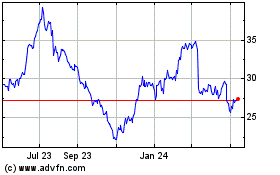U.S. stocks posted their biggest rally since the election,
sending major indexes to fresh records as investors increasingly
conclude President-elect Donald Trump will be good for business and
the economy.
Investors are embracing the prospect of tax cuts, regulatory
rollbacks and fiscal stimulus under Republican leadership in
Washington. Such bets have lifted shares of banks and industrial
companies and sent government bonds tumbling. The Dow Jones
Industrial Average rose nearly 300 points to a record Wednesday and
the S&P 500 also hit a fresh high.
Some investors have been wary of the postelection rally, citing
mixed signals around Mr. Trump's policy agenda, but many now expect
the gains to continue in 2017. Corporate earnings are on the mend,
the rate of U.S. economic growth has accelerated and the labor
market has continued to strengthen. Those factors should support
further gains in the stock market, and Mr. Trump's agenda is
bolstering investors' confidence, investors and analysts said.
"Things were already improving before the election," said Jeremy
Zirin, chief equity strategist at UBS Wealth Management Americas.
"What's happened since is that many of the progrowth trends have
been exacerbated, and the market is looking at Trump's policies as
likely to continue to boost growth."
Wednesday's rally took off in afternoon trading.
Market participants didn't see a specific catalyst for the surge
but speculated that large orders in stock futures placed by
computer programs accelerated buying broadly.
"People across the Street have been talking about a large buy
program that hit the market and caused a spike," said Jonathan
Corpina, senior managing partner at Meridian Equity Partners. "Then
you've got everyone jumping out on top of it and trying to play
catch up."
Shortly after 1:20 p.m. in New York, about 53,000 S&P 500
e-mini futures that expire in December traded within one minute,
according to Thomson Reuters data. That compares with the average
of 5,100 contracts a minute that traded during the rest of the time
the market was open Wednesday.
Futures on a stock index allow investors to bet on levels at a
future date, and trade outside of regular market hours as well as
during them. Traders sometimes use them when the broader market is
open because of their liquidity.
Wednesday's volume in the futures contracts totaled 2.31 million
shares, the highest since the two days after the U.S. election on
Nov. 8.
Bond yields have risen since the election as investors have
anticipated a higher-growth, inflationary environment, which can
erode the value of bonds' fixed payments. But some investors rushed
back into bonds on Wednesday, betting that the European Central
Bank would extend its €1.7 trillion ($1.83 trillion) bond-buying
program at its Thursday policy meeting.
The yield on the benchmark 10-year Treasury note fell to 2.347%
from 2.394% in the previous session. The yield was at 1.867% on
Nov. 8. Yields fall when prices rise.
Wednesday's rally in both stocks and bonds was a reminder that
easy-money policies featuring low rates have been a boon to stocks
since the financial crisis, as they have encouraged investors to
hunt for yield in the stock market.
The Dow Jones Industrial Average rose 297.84 points, or 1.5%, to
19549.62, and the S&P 500 rose 29.12 points, or 1.3%, to
2241.35. The Nasdaq Composite climbed 60.76 points, or 1.1%, to
5393.76.
It was the three indexes' best day since Nov. 7, a day after the
Federal Bureau of Investigation said no new evidence was found in
relation to Hillary Clinton's email practices that would warrant
charges against the Democratic presidential candidate.
Investors had largely been expecting a Clinton victory, but
quickly pivoted their focus to Mr. Trump's potential policies and
sent stocks on a weekslong rally.
The Dow Jones Transportation Average climbed 2.5% Wednesday to
its first record since Dec. 29, 2014, led by shares of airlines
including American Airlines Group.
Some investors consider the transportation index a proxy for the
strength of the economy because it includes train, truck and
shipping companies that carry the raw materials and goods used in
manufacturing and construction. The transport stocks are also
concentrated in the U.S., which puts them in a position to benefit
from protectionist policies advocated by Mr. Trump.
The economy is showing signs of strength, with gross domestic
product, the broadest measure of economic output, accelerating at
its fastest pace in two years in the third quarter, the Commerce
Department said. Some railroads and shippers have been boosted by a
rally in commodities.
While the broader market has rallied over the past month,
individual sectors and stocks have fluctuated on Mr. Trump's
comments. Health-care and biotechnology stocks slid Wednesday after
Mr. Trump was quoted in a Time magazine article as saying: "I'm
going to bring down drug prices."
Health care was the only S&P 500 sector to decline
Wednesday, and the Nasdaq Biotechnology Index fell 2.9%, its
biggest drop since Nov. 3.
Mr. Trump's comment "has shaken the biotech sector," said Mr.
Corpina of Meridian.
U.S. oil prices fell back below $50 a barrel, but that did
little to derail the stock rally. U.S. crude for January delivery
fell 2.3% to $49.77 a barrel, while energy shares rose 0.7% in the
S&P 500.
Aaron Kuriloff
Write to Akane Otani at akane.otani@wsj.com
(END) Dow Jones Newswires
December 07, 2016 19:05 ET (00:05 GMT)
Copyright (c) 2016 Dow Jones & Company, Inc.
Southwest Airlines (NYSE:LUV)
Historical Stock Chart
From Mar 2024 to Apr 2024

Southwest Airlines (NYSE:LUV)
Historical Stock Chart
From Apr 2023 to Apr 2024
